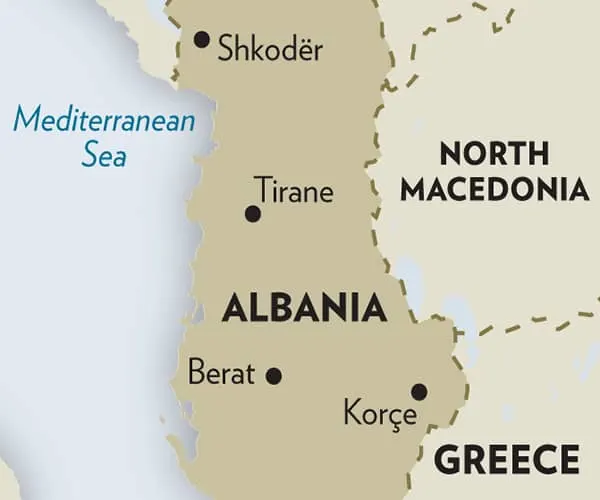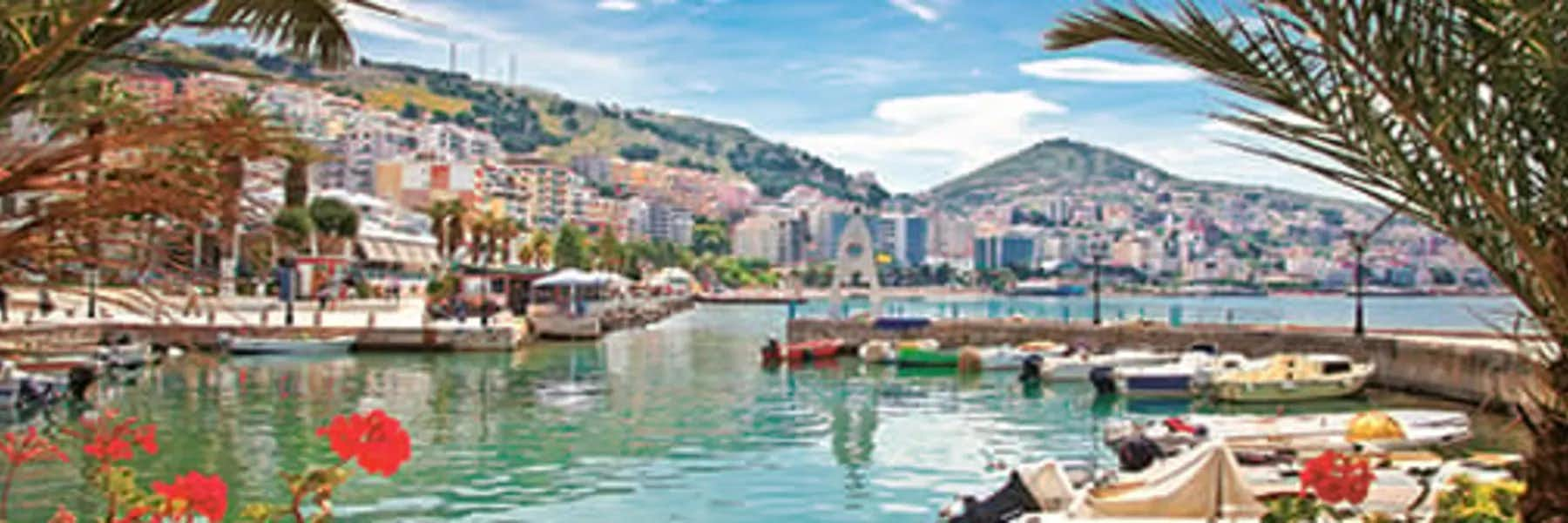Albania. Research this little country just north of Greece and you’ll see photo after photo of world-class beaches, imposing Ottoman architecture, smiling old men, and herds of shaggy goats. I was sold on it immediately (and not just because of the goats). It’s a small country—about the size of Massachusetts—but packs amazing diversity inside its borders, not to mention 150 miles of pristine Mediterranean coastline. There’s another reason to consider a trip: Albania has imposed no restrictions on travel during the COVID-19 pandemic. You’re free to enter and travel around the country, and better yet, U.S. citizens can stay up to a year, visa-free.
That’s not a misprint—you get a full year in a European destination, visa-free. Even if you just wanted to use it as a base for hopping in and out of the European Union countries without blowing your Schengen Area allocation (a maximum of 90 days in a 180-day period), Albania would be worth visiting. But once you’ve seen what’s on offer within its national borders, you may be reluctant to leave. Let’s look at a few of my favorite spots.
Berat: Arguably Europe’s Prettiest City
Intricately carved wooden windows adorn almost every ancient house clinging to the stone cliffs of the Osum River valley. I spent a full month in the city, renting a one-bedroom terraced apartment for only $150. I started every day with a hike up to Berat castle (a 13th-century Byzantine fortress) and drank in the view of the city as wood-stoves wafted smoke through the surrounding valley farmlands. A double espresso followed by a slice of byrek, a flaky pastry filled with cheese and spinach or meat, rounded out my mornings.
Berat’s markets are open for business by 10, and you can fill a bag with apples and oranges, zucchini, carrots, onions, eggplant, and the ripest red tomatoes imaginable, all for dimes. There was always a place in my refrigerator for a block of feta. Every vendor I ventured past offered me samples to choose from. You can pick up a pound of it for a dollar and change.
My apartment was next to the river in the historic Goriça neighborhood, and while many a lunch could be spent on my terrace with freshly baked bread and feta, I could also opt for the Texas-inspired charcoal grill tucked away in a neighborhood next to the soccer stadium. Sizzling links of pork and a plate of crispy fries, along with a generous serving of crunchy cucumbers and vine-ripened tomatoes bedding a thick slice of feta, ran me $3, including a cold bottle of Korça beer.
Along with pomegranates, figs, kake (persimmon), and various citrus fruits lining the cobblestone avenues (all free for the picking), Albania is bursting with grapes. Vines climb stone walls and hang from archways. I took a winery tour when I first arrived in Berat and was impressed with each of the samples I was given. Albanian wine is not famous, but it’s good.
GETTING THERE AND AROUND

Albania is one of the few European countries welcoming U.S. citizens during the COVID-19 era. Flying through the U.K. is the most affordable option. Direct flights leave from London to Tirana daily with British Airways, Wizz Air, and EasyJet. At the time of writing this, North Americans can transit through U.K. airports without quarantine restrictions, although a transit visa may be required (see Gov.uk/transit-visa for details).
Shkodër: Gateway to the Albanian Alps
It was early October and the beach had me wrapped comfortably in its sunny embrace, but I was itching to feel a bite of crisp fall air swirling through mountain pines. I’d heard about the “Albanian Alps” to the north and was intrigued by the thought of a glacier sliding slowly to the Adriatic. I took a shared furgon (minibus) to Shkodër and spent a few days exploring the picturesque city on bicycle, ducking into the art galleries and boutique stores that lined the brick avenues when I was so inclined, and stopping often for Turkish coffee and a pastry when I needed to refuel.
I was staying at a hotel that organizes homestays high in the Dinaric Alps, a mountain range that begins in Italy and ends in Albania. The hotel arranged for a taxi to take me to the breathlessly pristine Lake Koman, where a ferry carried me to another taxi that dropped me off at a stone house with a wrap-around terrace at the bottom of a glacial waterfall.
A family welcomed me with hot coffee, Greek salad, freshly baked bread, and a giant bowl of wild strawberries. It looked as if I had been transported to Lauterbrunnen in Switzerland. Sheer limestone protruded high into the clear, blue sky. Waterfalls cascaded down cliffs to join a frosty blue river slicing through the valley, forming an immovable border with the farm. I took off my shoes and paddled in the river, hoping that a bonfire and raki, an anise-flavored aperitif, would be included in the homestay. Note: it was.
ISN’T IT COMMUNIST?
First settled by the ancient Greeks, the land that is now Albania has passed through the hands of Roman emperors, Slavic conquerors, Venetian doges, and Serbian despots over the millennia. More recently, at the close of World War II, the newly proclaimed leader Enver Hoxha and his communist supporters dominated Albania until the fall of the Soviet Union.
Democracy emerged and Westernization began, but a government-supported Ponzi scheme took hold on a quarter of the population, leading to an evaporation of material wealth beginning in 1996 for close to a million people. Chaos ensued and scenes of violence dominated international headlines. Only after United Nations and Italian forces intervened did calm return.
Since those dark days 25 years ago, the country has made giant strides, joining NATO in 2009. Today, the country sits solidly on a recently laid foundation of judicial and economic reform, gender equality, and high quality of life. Healthcare is universal, and education is compulsory. Most young people speak English, German, and French. The gates are open. The bunkers are empty. Albania is begging to be explored.
Tirana: A Cosmopolitan Capital
After a couple of months in Albania, I had made a handful of expat friends, many of whom lived in the capital, Tirana. Apartments are a bit pricier there than in Berat (budget $300 a month for a two-bedroom with a terrace). The University of Tirana, with 35,000 students, skews the demographic much younger than surrounding areas. Live music emanates from rooftop bars at happy hour, and the shopping district reminds me of upscale Paris with Hemingway-era prices.
Art galleries and museums are abundant (the communist bunker tour is not to be missed), and late-night food cravings are whetted as you walk down wide, treelined avenues with aromas wafting from charcoal-grilled skewers of local pork and perfectly charred vegetables. Albania’s best hospitals are in Tirana, and a man I met, Jacob Henley from Newcastle, England had just recovered from a complete dental reconstruction. “It would have cost me $30,000 in England,” he said, smiling.
“Instead, I have a mouthful of new teeth for a third of the price.”
Public hospitals are free and adequate, but for private hospitals with top-notch doctors and more specialized care, insurance is essential. Bethany Price, from Albuquerque, New Mexico, has been living in Tirana for over a year and has no plans on leaving. “The city is so vibrant. The food scene is as good as it gets. And the people are so welcoming. I still can’t believe this country is a secret!”
Tirana is your last chance to sit at a café in a European city, sipping an Aperol spritz in the sun, and feel like you’ve discovered a place long before any pesky travel writer ruins it. Book your flight.
PLACES TO VISIT IN AND AROUND ALBANIA
Lake Ohrid is shared by Albania and North Macedonia and is the deepest lake in the Balkans. A short furgon ride from Tirana to Pogradec gets you to the border of North Macedonia and the silty brown sand surrounding the 5-million-year-old lake. The city of Ohrid in North Macedonia has a flawless 10th-century, red-roofed Orthodox church and a maze of ancient cobblestone streets. Over 200 freshwater species call the deep, spring-fed Lake Ohrid—and only Ohrid—their home. Rent a canoe for the best views of the depths below.
Përmet, back in Albania, is a secret destination. If you stayed there for a week, you might see 10 tourists. But you wouldn’t stay there for a week. The three-café town along the Vjosë River is surrounded by rural communities that are almost unchanged since the Middle Ages. A day hike transports you to a time where candles are cutting-edge, and the locals insist you eat dinner with the family and stay the night in the barn with the goat. A day or two is all you need to experience this time warp. Unless you like thermal baths… A short taxi ride outside of Përmet are the Benja Baths, a geothermal sulfur dip said to cure any physical ailment. A 500-year-old arched bridge frames the sheer cliffs of Langarica Canyon as bright blue mineral pools steam languidly beneath the rock walls. Hike for five minutes and you’ll have a deep pool to yourself.
Gjipe. I’ve spent a considerable amount of time researching which body of sand edging the Mediterranean is most suitable for human happiness, and when it comes to Albania, I have concluded that Gjipe Beach is the best. The town of Vuno sits on the mountainside, with abundant sea-view apartments and classy restaurants serving the finest seafood the Mediterranean has to offer, at Albanian prices.
A day hike through Gjipe Canyon winds for three miles through olive groves to sea turtle breeding grounds on a virgin beach. It’s a pleasant but wild day hike, so bring water, snacks, and good walking shoes. The crystalline water will surely beckon you to dive deep as soon as you lay eyes on it.
Related Articles
Europe’s Top 5 Affordable Retirement Havens
